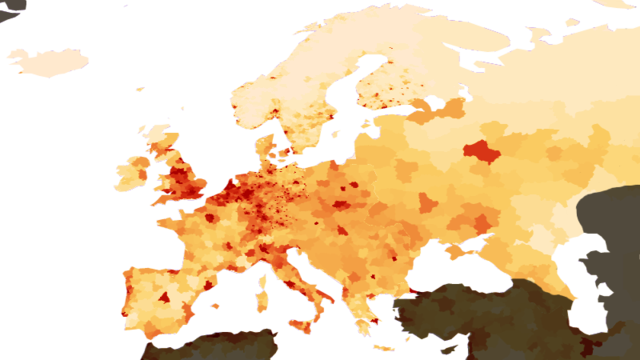Blue Banana
High population and GDP corridor in Europe From Wikipedia, the free encyclopedia
High population and GDP corridor in Europe From Wikipedia, the free encyclopedia
The Blue Banana (Dutch: blauwe banaan; French: banane bleue; German: Blaue Banane; Italian: banana blu), also known as the European Megalopolis or the Liverpool–Milan Axis, is a discontinuous corridor of urbanization in Western and Central Europe, with a population of around 100 million.[1][2] The conceptualisation of the area as a "Blue Banana" was developed in 1989 by RECLUS, a group of French geographers managed by Roger Brunet.[3]
This article has multiple issues. Please help improve it or discuss these issues on the talk page. (Learn how and when to remove these messages)
|

It stretches approximately from North West England through the English Midlands across Greater London to the European Metropolis of Lille, the Benelux states with the Dutch Randstad and Brussels and along the German Rhineland, Southern Germany, Alsace-Moselle in France in the west and Switzerland (Basel and Zürich) to Northern Italy (Milan, Turin, and Genoa) in the south.[4][5]


The French geographer Roger Brunet, who observed a division between "active" and "passive" spaces, developed the concept of a West European "backbone" in 1989. He made reference to an urban corridor of industry and services stretching from northern England to northern Italy.[3] The name "Blue Banana" was dually coined by Jacques Chérèque, and an artist adding a graphic to an article by Josette Alia in Le Nouvel Observateur. The colour blue referred to either the flag of the European Community, or the blue collars of factory workers in the region.[6]
Brunet saw the "European Backbone" as the development of historical precedents, e.g. trade routes, or as the consequence of an accumulation of industrial capital. In his analysis, Brunet excluded the Paris urban area and other French conurbations because of French economic insularity. His aim was a greater economic integration in Europe, but he felt that France had lost this connection by the 17th century as a result of its persecution of Huguenots and centralisation in Paris.[7][6] Later versions do, however, include Paris.[7]
In 1991, in the context of a study on behalf of the European Commission in support of its Regional Policy, researchers criticized the idea of the Blue Banana as a desirable formation, but not an empirical reality, identifying it as the result of regional competition in Europe. Furthermore, their diagram of the Blue Banana had more of a curve, still including Northern Italy, but ending at Barcelona. It also included Paris, and had the Anglo-Scottish border as its northern stem.[8] A study of the history of the Blue Banana as a concept refers to the commission's study as a mistaken rejection of the Blue Banana from Brunet's original conception. From the research on the commission's behalf, the Blue Banana represented a developed core at the expense of the periphery, whereas Brunet empirically viewed the Blue Banana as a region of development at Paris's periphery, beyond the French borders.[9] There are also considerations for an economically strong European pentagon with its borders Paris, London, Hamburg, Munich and Milan, with development axes towards the east (Berlin, Prague, Trieste).[10]
In recent years,[when?] the Blue Banana has been shifting north towards Germany, as industrialization draws in new populations towards the Northern European countries. Rapid urbanization led to an increase in slums and poverty stricken areas, which pushed European countries to implement new policies regarding urban renewal. Since the United Kingdom’s Action for Cities, France’s Reconquête Urbaine and Germany’s Städtebauförderung have been put in place, these urbanization policies have built a stronger foundation and better utilized urban spaces.[11] These policies allow countries to expand further, economically, just as Germany has done.
If current trends of urbanization continue, 72% of the world's population will live in cities by 2050.[12] This creates the need for the preparation of European countries to improve themselves to deal with the capacity of people that will move into the cities. Since the rapid increase of urbanization and more people moving to cities, the banana is growing instead of shifting.
Due to urbanization, the Blue Banana has become larger in size, branching outwards in a star shape. Despite this, the Blue Banana still remains the core of the conurbation.[1] Although the Blue Banana may not have the same formation it had decades ago, it still holds Europe’s largest gathering of people, industry, money, and economic power.
Seamless Wikipedia browsing. On steroids.
Every time you click a link to Wikipedia, Wiktionary or Wikiquote in your browser's search results, it will show the modern Wikiwand interface.
Wikiwand extension is a five stars, simple, with minimum permission required to keep your browsing private, safe and transparent.